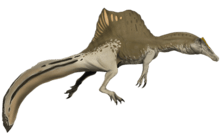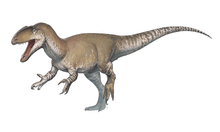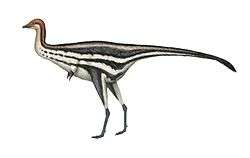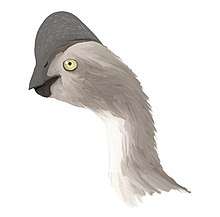Suzhousaurus
Suzhousaurus is a genus of herbivorous therizinosauroid theropod dinosaur from the Early Cretaceous-age Xinminbao Group of the Yujingzi Basin, Gansu, China.
| Suzhousaurus | |
|---|---|
| Restored skeleton | |
| Scientific classification | |
| Kingdom: | Animalia |
| Phylum: | Chordata |
| Clade: | Dinosauria |
| Clade: | Saurischia |
| Clade: | Theropoda |
| Superfamily: | †Therizinosauroidea |
| Genus: | †Suzhousaurus Li et al., 2007 |
| Species: | †S. megatherioides |
| Binomial name | |
| †Suzhousaurus megatherioides Li et al., 2007 | |
Discovery and naming
The type species Suzhousaurus megatherioides was named and described by Li Daqing, Peng Cuo, You Hailu, Matthew Lamanna, Jerrald Harris, Kenneth Lacovara and Zhang Jianping in 2007. The generic name is derived from Suzhou, the old name for Jiuquan, the prefecture the find was made in during the late twentieth century. The specific name indicates a resemblance to Megatherium, the giant ground sloth.[1]
The holotype, FRDC-GSJB-99, was found in layers dating to the Aptian-Albian. It consists of a partial skeleton lacking the skull. It contains a distinctive right upper arm that establishes it as a therizinosauroid, a right scapula, ten dorsal vertebrae, ribs, a partial ilium and the pubis.[1] In 2008 another partial postcranial skeleton was described, specimen FRDC-GSJB-2004-001 found in 2004 at the same site. It contains the last three dorsal vertebrae, a sacrum of five vertebrae, the first six tail vertebrae, the left half of a pelvis and two thighbones.[2]
Suzhousaurus might be identical to "Nanshiungosaurus" bohlini, an earlier named therizinosauroid found in the same formation and also known from limited remains. If so, the species name would be Suzhousaurus bohlini. A comparison is difficult because there is little overlapping material and the holotype of "Nanshiungosaurus" bohlini is lost.[1]
Description
Along with "Nanshiungosaurus" bohlini, which has the same age, Suzhousaurus was one of the largest known Early Cretaceous therizinosauroids.[1] In 2010 Gregory S. Paul estimated the body length at six metres, the weight at 1.3 tonnes.[3] Suzhousaurus is distinguished by a straight flat front part of the ilium and a flattened pubis curving strongly forward forming a hollow front edge of its shaft.[2]
Environment
Drexel University paleontologist Dr. Kenneth Lacovara described the environment as a "warm, semi-arid plain dotted with shallow, ephemeral lakes. It shared its world with a host of other Early Cretaceous dinosaurs, including giant, long-necked, plant-eating sauropods and early relatives of duck-billed herbivores.”[4]
Phylogeny
Li and coauthors, in their description of the genus, assigned Suzhousaurus to the Therizinosauroidea, in a basal position. They performed a cladistic analysis that found the genus to be more derived than Beipiaosaurus and Falcarius, less derived than Alxasaurus and true therizinosaurids, and the sister taxon of Nothronychus, forming a clade with it.[1]
An analysis by Lindsay Zanno in 2010 found a more derived position as the sister taxon of the Therizinosauridae, as shown by this cladogram:[5]
| Therizinosauria |
| |||||||||||||||||||||||||||||||||||||||||||||||||||||||||||||||
See also
References
- Li D.; Peng C.; You H.; Lamanna, M.C.; Harris, J.D.; Lacovara, K.J.; Zhang J. (2007). "A large therizinosauroid (Dinosauria: Theropoda) from the Early Cretaceous of northwestern China". Acta Geologica Sinica (English Edition). 81 (4): 539–549. doi:10.1111/j.1755-6724.2007.tb00977.x.
- Li, D., You, H., and Zhang, J. (2008). "A new specimen of Suzhousaurus megatherioides (Dinosauria: Therizinosauroidea) from the Early Cretaceous of northwestern China." Canadian Journal of Earth Sciences, 45(7): 769–779.
- Paul, G.S., 2010, The Princeton Field Guide to Dinosaurs, Princeton University Press p. 158
- http://drexel.edu/now/archive/2007/October/Drexel-Researcher-among-Team-that-Discovered-Giant-Feathered-Plant-Eating-Dinosaur-from-Ancient-Chin/
- Lindsay E. Zanno (2010). "A taxonomic and phylogenetic re-evaluation of Therizinosauria (Dinosauria: Maniraptora)". Journal of Systematic Palaeontology. 8 (4): 503–543. doi:10.1080/14772019.2010.488045.














